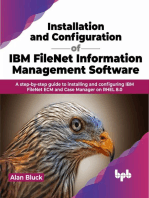How To Create and Debugging Linux Applications Using Sourcery Codebench For Arm Gnu Linux
Uploaded by
mihaiM500How To Create and Debugging Linux Applications Using Sourcery Codebench For Arm Gnu Linux
Uploaded by
mihaiM500HOW-TO GUIDE: CREATING AND DEBUGGING LINUX APPLICATIONS USING SOURCERY CODEBENCH FOR ARM GNU/LINUX
KATHLEEN OLIVER, TECHNICAL MARKETING ENGINEER
w w w.m e n t o r.c o m
H O W - T O W H I T E P A P E R
Creating and Debugging Linux Applications Using Sourcery CodeBench for ARM GNU/Linux
INTRODUCTION
These steps give an example of using Mentor Embedded Sourcery CodeBench Professional to create and debug an application that will run on a target running Linux. These steps were tested on a PandaBoard using the Mentor Embedded Linux Kit for PandaBoard kernel image, rootfs, u-boot, and MLO.
PREREQUISITES
Install CodeBench for ARM GNU/Linux Professional 2011.09 on Linux. Download and install the free Mentor Embedded Linux Kit for PandaBoard from http://www.mentor.com/embedded-software/downloads/linux-kits/. Follow the instructions in the PandaBoard Installation and Getting Started Guide to configure your SD card and boot the PandaBoard using the Mentor Embedded Linux Kit for PandaBoard images.
PROCEDURE
1. From the Host machine, start CodeBench for ARM GNU/Linux. 2. Create and build an application. 3. Set up your debug launch configuration and debug your application.
CREATING AND BUILDING AN APPLICATION
This first step to creating and building applications using Sourcery CodeBench is to create a project to work in. You will then need to add your source code and compile it to run on your target. Tip: Refer to the Sourcery CodeBench documentation (Help > Help Contents) for more information about creating projects in Sourcery CodeBench.
PROCEDURE
1. From CodeBench, select File > New > C or C++ Project. The New Project wizard opens.
a. Give your project a name and select the type of project to create. To start with example code, from the Project type area, select Executable > Factorial C Project. b. Click Next. This opens the Configuration page of the Project wizard. c. From the Processor list, select Cortex-A9. Note: We are using sysroot from the Mentor Embedded Linux Kit for PandaBoard, which is at the file system root location. If the sysroot on the target is not at the file system root location, enter the pathname to the location of the installed sysroot on the target. See also: Installing runtime support files on the target. d. Click Finish to create the project. 2. Add files to your project.
w w w. m e nto r. co m
Creating and Debugging Linux Applications Using Sourcery CodeBench for ARM GNU/Linux
3. Add the path to the include files and libraries in your project: a. From the Project Explorer, right-click the project and select Properties. This opens the Properties dialog box for the project. b. On the left of the Properties dialog box, expand C/C++ Build and select Settings. This displays the Settings pane on the right side of the Properties window.
c. From the Settings pane, select the Tool Settings tab. i. To add include paths, expand Sourcery CodeBench C/C++ Compiler and select Includes. ii. To add library paths, expand Sourcery CodeBench C Linker and select Libraries. Add any libraries that your project uses to the Libraries list. d. Click Apply to apply your changes. e. Click OK to close the Properties dialog box. 4. To build your project, right-click the project and select Build Project.
w w w. m e nto r. co m
Creating and Debugging Linux Applications Using Sourcery CodeBench for ARM GNU/Linux
NEXT STEP
Set up your debug launch configuration and debug your applications.
DOWNLOADING APPLICATIONS FROM CODEBENCH TO THE TARGET AND DEBUGGING
After building your applications you can download them to the target PandaBoard to run and debug them.
PREREQUISITES
Create and build an application. See Creating and Building an Application for the PandaBoard Using CodeBench. The PandaBoard must be booted and running Linux which is configured to support SSH and gdbserver. NOTE: If youre using the rootfs that ships with MEL-Lite for PandaBoard, this requirement is already met.
PROCEDURE
1. Select your project in the C/C++ Projects view. 2. Create a Debug launch configuration for your project: a. Select Run > Debug Configurations. This opens the Debug Configurations dialog box.
3. Select the Sourcery CodeBench Debug launch group and click New launch configuration.
w w w. m e nto r. co m
Creating and Debugging Linux Applications Using Sourcery CodeBench for ARM GNU/Linux
4. Select the Main tab of the launch configuration.
a. Enter a Name. b. Select Copy and launch application on remote system. c. Select the Connection for the target. If a connection to the remote system does not exist, click New to create one. This opens the New Connection dialog box. i. Enter the IP address for the target in the Host name field and enter a Connection name to label this connection.
ii. Click Finish to create the connection.
w w w. m e nto r. co m 5
Creating and Debugging Linux Applications Using Sourcery CodeBench for ARM GNU/Linux
d. Optionally, in the Remote path field, enter the path to the location to download your application to on the target with a filename for the application. If you dont do this, your application is downloaded to $HOME. e. Click Apply. 5. Select the Debugger tab for the launch configuration. a. Select the Shared Libraries tab and do the following: i. Select the Translate the specified shared library pathnames and set the pathname on target to the location of the sysroot that you setup on the PandaBoard. See Installing runtime support files on the target. ii. If you have additional shared libraries, click Add to add them to the Additional shared library directories list. iii. Click Apply. b. Select the Connection tab and to the following. i. Enter the Host name or IP address for the target. ii. Set the Port number to 10000. iii. Click Apply.
6. Click Debug to download your application to the target and begin debugging.
w w w. m e nto r. co m
Creating and Debugging Linux Applications Using Sourcery CodeBench for ARM GNU/Linux
7. If the Enter Password dialog box opens, enter the user ID and password for your kernel. For the MEL-Lite for PandaBoard kernel, the User ID is Root and there is no password, so leave the password field blank:
RESULTS
This copies your application to the target and starts your debugging session, which opens the Debug Launch Configuration. Refer to the Sourcery CodeBench Debugger documentation (Help > Help Contents) for more information about debugging with GDB.
INSTALLING RUNTIME SUPPORT FILES ON THE TARGET
NOTE: For more detailed information on this topic, refer to Section 3.6 of the Sourcery CodeBench for ARM/GNU Linux Getting Started Guide. In order to run and debug programs produced by Sourcery CodeBench on a GNU/Linux target, you must install runtime support files on the target. You may also need to set appropriate build options so that your executables can find the correct dynamic linker and libraries at runtime. The runtime support files, referred to as the sysroot, are found in the arm-none-linux-gnueabi/libc directory of your Sourcery CodeBench installation. The sysroot consists of the contents of the etc, lib, sbin, and usr directories. There may be other directories in arm-none-linux-gnueabi/libc that contain additional sysroots customized for particular combinations of command-line compiler flags, or multilibs. Refer to Section 3.2, Library Configurations of the Sourcery CodeBench Getting Started guide for a list of the included multilibs in this version of Sourcery CodeBench, and the corresponding sysroot directory pathnames. For each included multilib, Sourcery CodeBench provides both the full sysroot, unpacked on the host in the same directory hierarchy as it should be installed on the target, and a minimal sysroot packaged as a single .tar.bz2 file for easy transfer to and installation on the target. The minimal sysroot is suitable for initial development of many applications; it is much smaller than the full sysroot because it does not include locale, timezone, or character set conversion support. If your application requires some of those features, you may use the minimal sysroot as a base and copy the additional files required manually from the full sysroot.
w w w. m e nto r. co m
Creating and Debugging Linux Applications Using Sourcery CodeBench for ARM GNU/Linux
You have these choices for installing the sysroot on the target: You can install the files in the filesystem root on the target (that is, installing the files directly in /etc/, /lib/, and so on). All applications on the target then automatically use the Sourcery CodeBench libraries. This method is primarily useful when you are building a GNU/Linux root filesystem from scratch. If your target board already has a GNU/Linux filesystem installed, overwriting the existing C library files is not recommended, as this may break other applications on your system, or cause it to fail to boot. You can install the sysroot in an alternate location and invoke your application through the sysroot-run utility. If you are just getting started with Sourcery CodeBench, this may be the easiest way to get your application running on the target. The QEMU user-space emulator, which runs on GNU/Linux host systems, can likewise be invoked as sysroot-qemu to access the sysroot files from your Sourcery CodeBench installation directory on the host system. This is the recommended way to run QEMU and is also used when running user-space QEMU from the Sourcery CodeBench IDE. You can install the sysroot in an alternate location and build your application with the -rpath and --dynamic-linker linker options to specify the sysroot location. Setting the environment variable LD_LIBRARY_PATH on the target is not sufficient, since executables produced by Sourcery CodeBench depend on the Sourcery CodeBench dynamic linker included in the sysroot as well as the Sourcery CodeBench runtime libraries.
For additional information, please visit: mentor.com/embedded
Linux is the registered trademark of Linus Torvalds in the U.S. and other countries.
For the latest product information, call us or visit:
w w w.m e n t o r.c o m
2012 Mentor Graphics Corporation, all rights reserved. This document contains information that is proprietary to Mentor Graphics Corporation and may be duplicated in whole or in part by the original recipient for internal business purposes only, provided that this entire notice appears in all copies. In accepting this document, the recipient agrees to make every reasonable effort to prevent unauthorized use of this information. All trademarks mentioned in this document are the trademarks of their respective owners.
MGC 02-12
TECH10530-w
You might also like
- Installation and Configuration of IBM FileNet Information Management Software: A step-by-step guide to installing and configuring IBM FileNet ECM and Case Manager on RHEL 8.0 (English Edition)From EverandInstallation and Configuration of IBM FileNet Information Management Software: A step-by-step guide to installing and configuring IBM FileNet ECM and Case Manager on RHEL 8.0 (English Edition)No ratings yet
- C# For Beginners: An Introduction to C# Programming with Tutorials and Hands-On ExamplesFrom EverandC# For Beginners: An Introduction to C# Programming with Tutorials and Hands-On Examples5/5 (1)
- C Programming For Beginners: The Simple Guide to Learning C Programming Language Fast!From EverandC Programming For Beginners: The Simple Guide to Learning C Programming Language Fast!5/5 (1)
- Programming Exercise: Analyzing Baby Names Assignment: Java Programming: Solving Problems With SoftwareNo ratings yetProgramming Exercise: Analyzing Baby Names Assignment: Java Programming: Solving Problems With Software3 pages
- Debugging The Linux Kernel With Sourcery CodeBench and Mentor Embedded Sourcery ProbeNo ratings yetDebugging The Linux Kernel With Sourcery CodeBench and Mentor Embedded Sourcery Probe11 pages
- C Programming Wizardry: From Zero to Hero in 10 Days: Programming Prodigy: From Novice to Virtuoso in 10 DaysFrom EverandC Programming Wizardry: From Zero to Hero in 10 Days: Programming Prodigy: From Novice to Virtuoso in 10 DaysNo ratings yet
- C# Programming Illustrated Guide For Beginners & Intermediates: The Future Is Here! Learning By Doing ApproachFrom EverandC# Programming Illustrated Guide For Beginners & Intermediates: The Future Is Here! Learning By Doing ApproachNo ratings yet
- Building A Linux Kernel Using Sourcery CodeBenchNo ratings yetBuilding A Linux Kernel Using Sourcery CodeBench12 pages
- Professional Node.js: Building Javascript Based Scalable SoftwareFrom EverandProfessional Node.js: Building Javascript Based Scalable SoftwareNo ratings yet
- Evaluation of Some Android Emulators and Installation of Android OS on Virtualbox and VMwareFrom EverandEvaluation of Some Android Emulators and Installation of Android OS on Virtualbox and VMwareNo ratings yet
- Evaluation of Some Cloud Based Virtual Private Server (VPS) ProvidersFrom EverandEvaluation of Some Cloud Based Virtual Private Server (VPS) ProvidersNo ratings yet
- Coding Basics with Microsoft Visual Studio: A Step-by-Step Guide to Microsoft Cloud ServicesFrom EverandCoding Basics with Microsoft Visual Studio: A Step-by-Step Guide to Microsoft Cloud ServicesNo ratings yet
- Game and Graphics Programming for iOS and Android with OpenGL ES 2.0From EverandGame and Graphics Programming for iOS and Android with OpenGL ES 2.0No ratings yet
- Sourcery G++ Lite 2008q3-72 Getting-StartedNo ratings yetSourcery G++ Lite 2008q3-72 Getting-Started62 pages
- Introduction to Python Programming: Learn Coding with Hands-On Projects for BeginnersFrom EverandIntroduction to Python Programming: Learn Coding with Hands-On Projects for BeginnersNo ratings yet
- Learn Docker - .NET Core, Java, Node.JS, PHP or Python: Learn CollectionFrom EverandLearn Docker - .NET Core, Java, Node.JS, PHP or Python: Learn Collection5/5 (4)
- Python for Beginners: An Introduction to Learn Python Programming with Tutorials and Hands-On ExamplesFrom EverandPython for Beginners: An Introduction to Learn Python Programming with Tutorials and Hands-On Examples4/5 (2)
- Docker Tutorial for Beginners: Learn Programming, Containers, Data Structures, Software Engineering, and CodingFrom EverandDocker Tutorial for Beginners: Learn Programming, Containers, Data Structures, Software Engineering, and Coding3/5 (2)
- C Programming: C Programming Language for beginners, teaching you how to learn to code in C fast!From EverandC Programming: C Programming Language for beginners, teaching you how to learn to code in C fast!No ratings yet
- Installation, Upgrade, and Configuration of IBM Cognos Analytics: Smooth Onboarding of Data Analytics and Business Intelligence on Red Hat RHEL 8.0, IBM Cloud Private, and Windows ServersFrom EverandInstallation, Upgrade, and Configuration of IBM Cognos Analytics: Smooth Onboarding of Data Analytics and Business Intelligence on Red Hat RHEL 8.0, IBM Cloud Private, and Windows ServersNo ratings yet
- PYTHON FOR BEGINNERS: A Comprehensive Guide to Learning Python Programming from Scratch (2023)From EverandPYTHON FOR BEGINNERS: A Comprehensive Guide to Learning Python Programming from Scratch (2023)No ratings yet
- C++ Basics for New Programmers: A Practical Guide with ExamplesFrom EverandC++ Basics for New Programmers: A Practical Guide with ExamplesNo ratings yet
- IBM DB2 Administration Guide: Installation, Upgrade and Configuration of IBM DB2 on RHEL 8, Windows 10 and IBM Cloud (English Edition)From EverandIBM DB2 Administration Guide: Installation, Upgrade and Configuration of IBM DB2 on RHEL 8, Windows 10 and IBM Cloud (English Edition)No ratings yet
- CMake Best Practices: Upgrade your C++ builds with CMake for maximum efficiency and scalabilityFrom EverandCMake Best Practices: Upgrade your C++ builds with CMake for maximum efficiency and scalabilityNo ratings yet
- Evaluation of Some Windows and Linux Intrusion Detection ToolsFrom EverandEvaluation of Some Windows and Linux Intrusion Detection ToolsNo ratings yet
- Evaluation of Some Intrusion Detection and Vulnerability Assessment ToolsFrom EverandEvaluation of Some Intrusion Detection and Vulnerability Assessment ToolsNo ratings yet
- JAVASCRIPT FRONT END PROGRAMMING: Crafting Dynamic and Interactive User Interfaces with JavaScript (2024 Guide for Beginners)From EverandJAVASCRIPT FRONT END PROGRAMMING: Crafting Dynamic and Interactive User Interfaces with JavaScript (2024 Guide for Beginners)No ratings yet
- Cross-Platform Modern Apps with VS Code: Combine the power of EF Core, ASP.NET Core and Xamarin.Forms to build multi-platform applications on Visual Studio CodeFrom EverandCross-Platform Modern Apps with VS Code: Combine the power of EF Core, ASP.NET Core and Xamarin.Forms to build multi-platform applications on Visual Studio CodeNo ratings yet
- Learn C# From Scratch in One Hour C# Book for Absolute Beginners with Hands On exercises and Real-World Examples the one book you need to quickly Master C# Programming,: No prior experience is requiredFrom EverandLearn C# From Scratch in One Hour C# Book for Absolute Beginners with Hands On exercises and Real-World Examples the one book you need to quickly Master C# Programming,: No prior experience is requiredNo ratings yet
- Learn Kubernetes & Docker - .NET Core, Java, Node.JS, PHP or PythonFrom EverandLearn Kubernetes & Docker - .NET Core, Java, Node.JS, PHP or PythonNo ratings yet
- C Programming for the Pc the Mac and the Arduino Microcontroller SystemFrom EverandC Programming for the Pc the Mac and the Arduino Microcontroller SystemNo ratings yet
- Monitoring Radio Link and TDM Performance MINI-LINK 6600No ratings yetMonitoring Radio Link and TDM Performance MINI-LINK 660014 pages
- Event Management System Design and ImplementationNo ratings yetEvent Management System Design and Implementation11 pages
- Instructions, Fetch, Execution Cycle and Concept of Operand, Register and StorageNo ratings yetInstructions, Fetch, Execution Cycle and Concept of Operand, Register and Storage22 pages
- Overview of Command Prompt For Data RecoveryNo ratings yetOverview of Command Prompt For Data Recovery6 pages
- Ijert Ijert: Design and Implementation of Encoder For (15, K) Binary BCH Code Using VHDLNo ratings yetIjert Ijert: Design and Implementation of Encoder For (15, K) Binary BCH Code Using VHDL5 pages
- Mini Project Phase 1 Seminar PPT TemplateNo ratings yetMini Project Phase 1 Seminar PPT Template13 pages
- HPE Virtual Connect SE 100Gb F32 Module For SynergyNo ratings yetHPE Virtual Connect SE 100Gb F32 Module For Synergy18 pages
- AM65x Processors Silicon Revision 2.1, 2.0, 1.0: ErrataNo ratings yetAM65x Processors Silicon Revision 2.1, 2.0, 1.0: Errata53 pages
- Workshop 9 Dune Buggy Frame Structure - Vertically Supported With SpringsNo ratings yetWorkshop 9 Dune Buggy Frame Structure - Vertically Supported With Springs18 pages
- Ubiquiti Home Network Project Instructions 2023100% (1)Ubiquiti Home Network Project Instructions 2023222 pages
- Seplos Smart BMS 3.0 16s100a - 20230425104921No ratings yetSeplos Smart BMS 3.0 16s100a - 2023042510492131 pages
- Installation and Configuration of IBM FileNet Information Management Software: A step-by-step guide to installing and configuring IBM FileNet ECM and Case Manager on RHEL 8.0 (English Edition)From EverandInstallation and Configuration of IBM FileNet Information Management Software: A step-by-step guide to installing and configuring IBM FileNet ECM and Case Manager on RHEL 8.0 (English Edition)
- C# For Beginners: An Introduction to C# Programming with Tutorials and Hands-On ExamplesFrom EverandC# For Beginners: An Introduction to C# Programming with Tutorials and Hands-On Examples
- C Programming For Beginners: The Simple Guide to Learning C Programming Language Fast!From EverandC Programming For Beginners: The Simple Guide to Learning C Programming Language Fast!
- SRS - How to build a Pen Test and Hacking PlatformFrom EverandSRS - How to build a Pen Test and Hacking Platform
- Programming Exercise: Analyzing Baby Names Assignment: Java Programming: Solving Problems With SoftwareProgramming Exercise: Analyzing Baby Names Assignment: Java Programming: Solving Problems With Software
- Debugging The Linux Kernel With Sourcery CodeBench and Mentor Embedded Sourcery ProbeDebugging The Linux Kernel With Sourcery CodeBench and Mentor Embedded Sourcery Probe
- C Programming Wizardry: From Zero to Hero in 10 Days: Programming Prodigy: From Novice to Virtuoso in 10 DaysFrom EverandC Programming Wizardry: From Zero to Hero in 10 Days: Programming Prodigy: From Novice to Virtuoso in 10 Days
- C# Programming Illustrated Guide For Beginners & Intermediates: The Future Is Here! Learning By Doing ApproachFrom EverandC# Programming Illustrated Guide For Beginners & Intermediates: The Future Is Here! Learning By Doing Approach
- Professional Node.js: Building Javascript Based Scalable SoftwareFrom EverandProfessional Node.js: Building Javascript Based Scalable Software
- Evaluation of Some Android Emulators and Installation of Android OS on Virtualbox and VMwareFrom EverandEvaluation of Some Android Emulators and Installation of Android OS on Virtualbox and VMware
- Evaluation of Some Cloud Based Virtual Private Server (VPS) ProvidersFrom EverandEvaluation of Some Cloud Based Virtual Private Server (VPS) Providers
- Coding Basics with Microsoft Visual Studio: A Step-by-Step Guide to Microsoft Cloud ServicesFrom EverandCoding Basics with Microsoft Visual Studio: A Step-by-Step Guide to Microsoft Cloud Services
- Game and Graphics Programming for iOS and Android with OpenGL ES 2.0From EverandGame and Graphics Programming for iOS and Android with OpenGL ES 2.0
- C Clearly - Programming With C In Linux and On Raspberry PiFrom EverandC Clearly - Programming With C In Linux and On Raspberry Pi
- Introduction to Python Programming: Learn Coding with Hands-On Projects for BeginnersFrom EverandIntroduction to Python Programming: Learn Coding with Hands-On Projects for Beginners
- Learn Docker - .NET Core, Java, Node.JS, PHP or Python: Learn CollectionFrom EverandLearn Docker - .NET Core, Java, Node.JS, PHP or Python: Learn Collection
- Python for Beginners: An Introduction to Learn Python Programming with Tutorials and Hands-On ExamplesFrom EverandPython for Beginners: An Introduction to Learn Python Programming with Tutorials and Hands-On Examples
- Docker Tutorial for Beginners: Learn Programming, Containers, Data Structures, Software Engineering, and CodingFrom EverandDocker Tutorial for Beginners: Learn Programming, Containers, Data Structures, Software Engineering, and Coding
- C Programming: C Programming Language for beginners, teaching you how to learn to code in C fast!From EverandC Programming: C Programming Language for beginners, teaching you how to learn to code in C fast!
- Installation, Upgrade, and Configuration of IBM Cognos Analytics: Smooth Onboarding of Data Analytics and Business Intelligence on Red Hat RHEL 8.0, IBM Cloud Private, and Windows ServersFrom EverandInstallation, Upgrade, and Configuration of IBM Cognos Analytics: Smooth Onboarding of Data Analytics and Business Intelligence on Red Hat RHEL 8.0, IBM Cloud Private, and Windows Servers
- PYTHON FOR BEGINNERS: A Comprehensive Guide to Learning Python Programming from Scratch (2023)From EverandPYTHON FOR BEGINNERS: A Comprehensive Guide to Learning Python Programming from Scratch (2023)
- C++ Basics for New Programmers: A Practical Guide with ExamplesFrom EverandC++ Basics for New Programmers: A Practical Guide with Examples
- IBM DB2 Administration Guide: Installation, Upgrade and Configuration of IBM DB2 on RHEL 8, Windows 10 and IBM Cloud (English Edition)From EverandIBM DB2 Administration Guide: Installation, Upgrade and Configuration of IBM DB2 on RHEL 8, Windows 10 and IBM Cloud (English Edition)
- CMake Best Practices: Upgrade your C++ builds with CMake for maximum efficiency and scalabilityFrom EverandCMake Best Practices: Upgrade your C++ builds with CMake for maximum efficiency and scalability
- Evaluation of Some Windows and Linux Intrusion Detection ToolsFrom EverandEvaluation of Some Windows and Linux Intrusion Detection Tools
- Evaluation of Some Intrusion Detection and Vulnerability Assessment ToolsFrom EverandEvaluation of Some Intrusion Detection and Vulnerability Assessment Tools
- JAVASCRIPT FRONT END PROGRAMMING: Crafting Dynamic and Interactive User Interfaces with JavaScript (2024 Guide for Beginners)From EverandJAVASCRIPT FRONT END PROGRAMMING: Crafting Dynamic and Interactive User Interfaces with JavaScript (2024 Guide for Beginners)
- Cross-Platform Modern Apps with VS Code: Combine the power of EF Core, ASP.NET Core and Xamarin.Forms to build multi-platform applications on Visual Studio CodeFrom EverandCross-Platform Modern Apps with VS Code: Combine the power of EF Core, ASP.NET Core and Xamarin.Forms to build multi-platform applications on Visual Studio Code
- Learn C# From Scratch in One Hour C# Book for Absolute Beginners with Hands On exercises and Real-World Examples the one book you need to quickly Master C# Programming,: No prior experience is requiredFrom EverandLearn C# From Scratch in One Hour C# Book for Absolute Beginners with Hands On exercises and Real-World Examples the one book you need to quickly Master C# Programming,: No prior experience is required
- Learn Kubernetes & Docker - .NET Core, Java, Node.JS, PHP or PythonFrom EverandLearn Kubernetes & Docker - .NET Core, Java, Node.JS, PHP or Python
- Schaum's Easy Outline of Programming with JavaFrom EverandSchaum's Easy Outline of Programming with Java
- PHP MySQL Development of Login Modul: 3 hours Easy GuideFrom EverandPHP MySQL Development of Login Modul: 3 hours Easy Guide
- C Programming for the Pc the Mac and the Arduino Microcontroller SystemFrom EverandC Programming for the Pc the Mac and the Arduino Microcontroller System
- Monitoring Radio Link and TDM Performance MINI-LINK 6600Monitoring Radio Link and TDM Performance MINI-LINK 6600
- Instructions, Fetch, Execution Cycle and Concept of Operand, Register and StorageInstructions, Fetch, Execution Cycle and Concept of Operand, Register and Storage
- Ijert Ijert: Design and Implementation of Encoder For (15, K) Binary BCH Code Using VHDLIjert Ijert: Design and Implementation of Encoder For (15, K) Binary BCH Code Using VHDL
- HPE Virtual Connect SE 100Gb F32 Module For SynergyHPE Virtual Connect SE 100Gb F32 Module For Synergy
- AM65x Processors Silicon Revision 2.1, 2.0, 1.0: ErrataAM65x Processors Silicon Revision 2.1, 2.0, 1.0: Errata
- Workshop 9 Dune Buggy Frame Structure - Vertically Supported With SpringsWorkshop 9 Dune Buggy Frame Structure - Vertically Supported With Springs





























































































